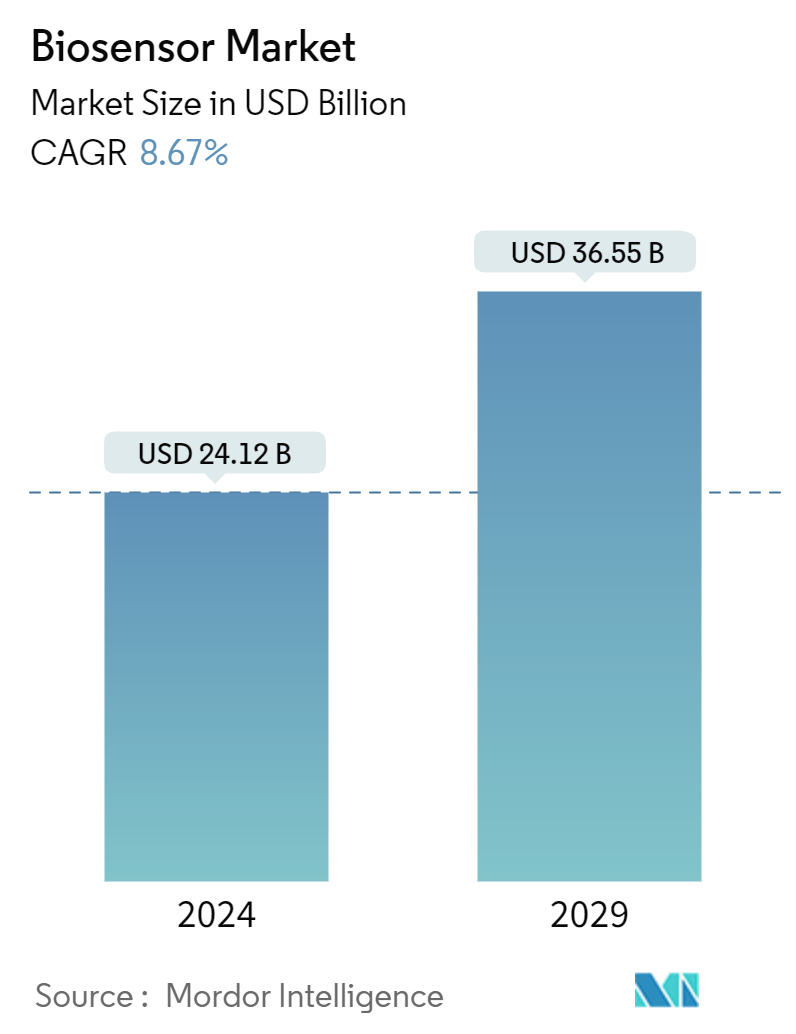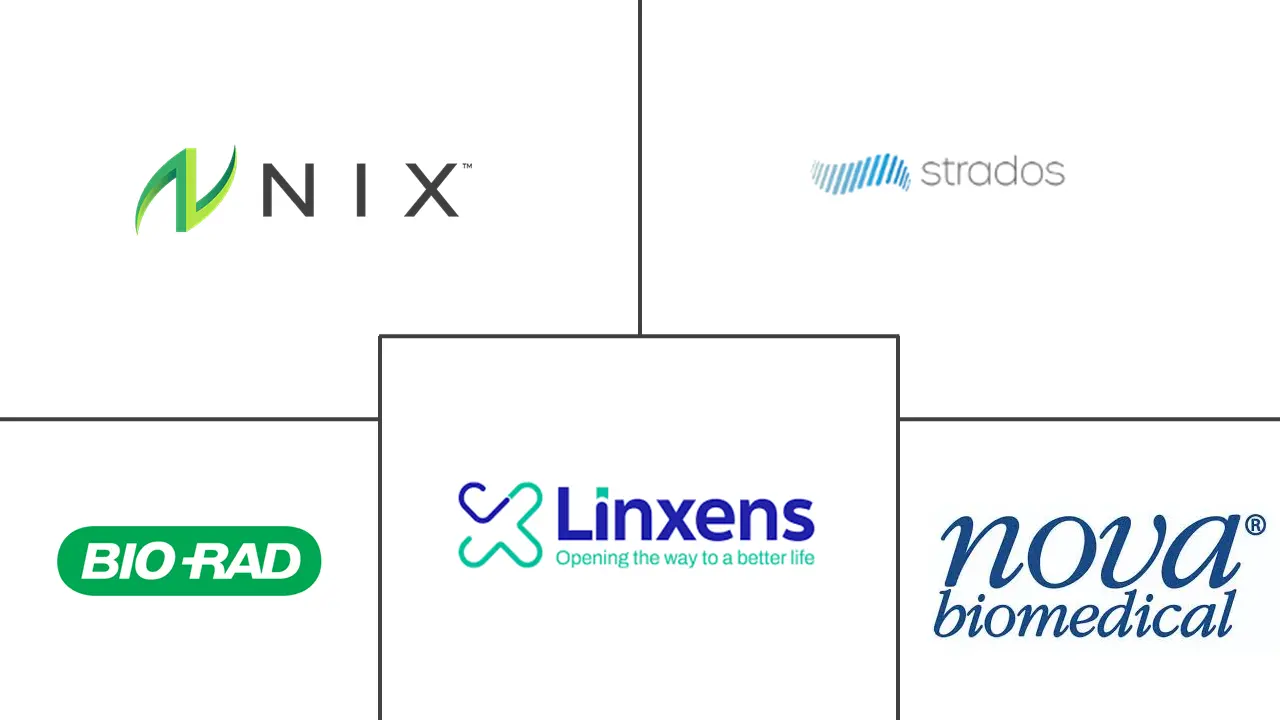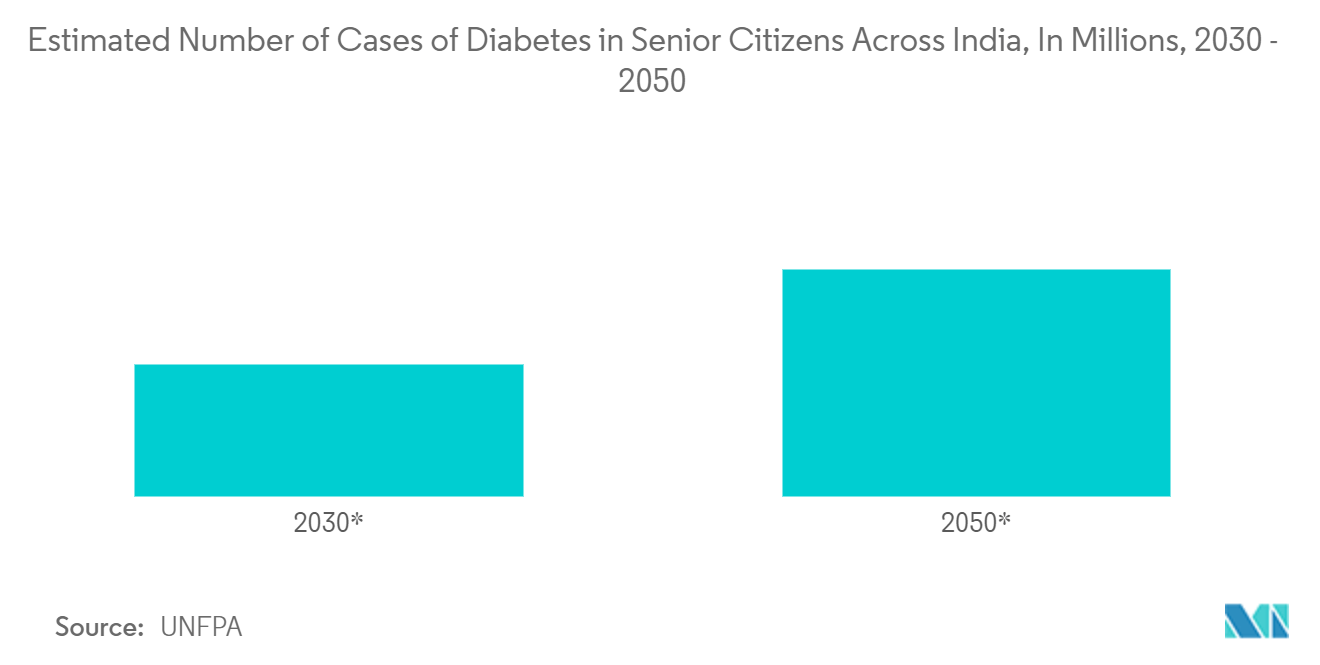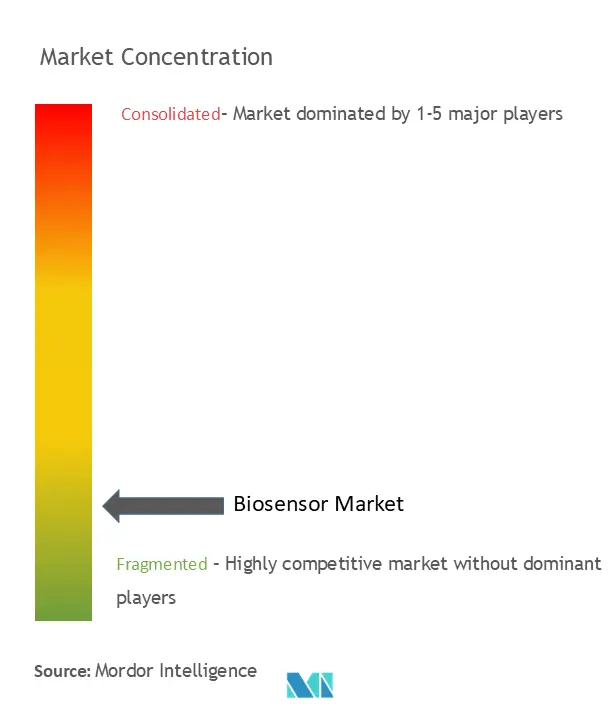Biosensor Market Size

| Study Period | 2019 - 2029 |
| Market Size (2024) | USD 24.12 Billion |
| Market Size (2029) | USD 36.55 Billion |
| CAGR (2024 - 2029) | 8.67 % |
| Fastest Growing Market | Asia Pacific |
| Largest Market | North America |
Major Players
*Disclaimer: Major Players sorted in no particular order |
Biosensor Market Analysis
The Biosensor Market size is estimated at USD 24.12 billion in 2024, and is expected to reach USD 36.55 billion by 2029, growing at a CAGR of 8.67% during the forecast period (2024-2029).
- Biosensors are sensing devices that measure a reaction between bodily fluids and enzymes. One of the most common examples of a biosensor is a blood glucose strip for diabetes patients. These sensors can also gather other blood, sweat, and saliva information. In recent years, the imperative usage of biosensors in several applications, like the biomedical, food industry, clinical analysis, defense, safety, environmental monitoring, etc., has led to significant importance and demand to fabricate them.
- Furthermore, due to the prevalence of chronic and lifestyle-related ailments, consumers are increasingly urged to use biosensors to detect pathogenic activities in the body regularly, which is projected to drive the demand for biosensors. The application of biosensors is also expanding due to their increased availability and affordability due to the adoption of nanotechnology and the rising elderly population worldwide.
- Portable, flexible biosensors represent a rapidly growing and increasingly important area of research. There are some significant advantages of portable, flexible biosensors, such as a more user-friendly design, less affected by external conditions, the ability to provide test results quickly, low production cost the production cost and the ability to be fitted to the skin to achieve more real-time sampling. Many biosensor substrate materials come from polymers; perfect fabrication technology and abundant polymers strongly support the development of portable, flexible sensors.
- Paper-based biosensors have also received considerable interest in recent years owing to their advantages, such as portability, foldability, and accessibility. Another significant advantage driving interest in paper-based biosensors is the ease with which the surface of paper-based biosensors can be modified with nanomaterials and biomolecules, significantly improving the sensing performance. The other necessary type of flexible biosensors uses textiles as substrate materials, the prospect of which is also promising in the area of wearable sensors due to the knittable nature of the fabric.
- In recent years, the commercialization of biosensor technology has needed to be more active, primarily due to high costs and a demand that has largely been confined to the healthcare sector. Industry players face hurdles in commercializing biosensors for non-medical uses, like biodefense and military applications, mainly because of limited R&D efforts and the need for more positive outcomes. Compounding these challenges, the biosensors market is also expected to be hindered by the costs tied to R&D, coupled with protracted certification and approval cycles. Furthermore, the market grapples with challenges such as hesitance to adopt new treatment methodologies and pricing pressures in POC settings.
- Regulatory policies concerning healthcare devices are the macroeconomic factors influencing the market's growth trajectory. Stricter regulations can decelerate the market by elongating the time and inflating the costs of launching new products. Moreover, although emerging economies offer substantial growth potential, their constrained healthcare budgets and underdeveloped infrastructure can hinder the widespread adoption of biosensors. This limitation is further exacerbated by lower-income populations' inability to afford these technologies, constraining the market's expansion.
Biosensor Market Trends
Medical is Expected to Witness a Significant Growth
- The global rise in diabetes, especially type 2 diabetes, has led to a greater need for continuous blood glucose monitoring. This drives the demand for biosensors that can accurately measure glucose levels. The demand for reliable glucose biosensors increases as early detection and constant management of blood glucose levels become more critical in preventing complications. UNFPA projected that by 2030, approximately 19.3 million senior citizens in India will be diagnosed with diabetes, with the number expected to rise to around 33.3 million by 2050.
- Growing awareness of the importance of regular blood glucose monitoring among diabetes patients has resulted in higher adoption of glucose biosensors. Government initiatives and healthcare policies aimed at managing diabetes more effectively also promote the use of glucose-monitoring devices, further driving the demand for biosensors. For instance, India has launched an application named mDiabetes to harness mobile technology. The app aims to raise awareness, promote treatment adherence, and instill healthy habits in the general public. Additionally, media campaigns are being conducted to highlight the risk factors associated with diabetes.
- Innovations in biosensor technology, such as continuous glucose monitoring (CGM) systems, which allow non-invasive and real-time monitoring, are becoming increasingly popular. These advancements fuel demand as they offer greater convenience and accuracy than traditional finger-prick methods. In June 2024, Abbott and Dexcom are set to debut the first over-the-counter continuous glucose monitoring systems (CGMs). This launch in the United States aims to promote the broader adoption of these devices.
- Growing demand for cost-effective and practical analytical techniques has spotlighted biosensors in medical drug determinations. Compared to conventional methods, biosensors stand out as unique and effective devices. Various electrode modification materials and biorecognition elements are employed to construct these biosensors for drug determination. Furthermore, multiple construction strategies have been devised to boost biosensor performance. In the coming years, technological advancements are set to deliver cost-effective, sensitive, and selective biosensors for analyzing drugs in both drug formulations and biological samples.

North America is Expected to Hold a Significant Market Share
- North America has one of the highest prevalence rates of diabetes, particularly in the United States. Continuous monitoring has led to substantial demand for glucose biosensors, including glucose monitors (CGMs) and traditional glucose meters. In addition, the region also has a high incidence of cardiovascular diseases, which has driven demand for biosensors that can monitor cardiac biomarkers, enabling early detection and management of heat conditions.
- In February 2024, researchers from Colorado State University are working to transition heart failure screening from laboratories to the comfort of home. Their prototype, an electrochemical biosensor akin to a transparent lateral flow test for COVID-19, can detect two heart failure biomarkers within 15 minutes using only a drop of saliva. This device is designed for individuals at high risk of heart failure, especially those with limited access to hospitals or centralized labs. To develop the handheld testing platform, the team merged two prior innovations - a saliva microfluidic device and a biosensor targeting biomarker proteins Galectin-3 and S100A7.
- The United States FDA (Food and Drug Administration) has expedited the approval processes for biosensor technologies, paving the way for the market entry of new and innovative products into the market. This supportive regulatory environment encourages innovation and drives the demand for new biosensor solutions. Moreover, improved reimbursement policies for biosensor devices, particularly those managing chronic conditions like diabetes and heart disease, have made these technologies more accessible to a broader population, increasing demand.
- North America is home to numerous leading biosensor manufacturers and research institutions that invest heavily in R&D. This focus on innovation drives the development of new and improved biosensors, particularly in areas like non-invasive monitoring, wearable devices, and point-of-care diagnostics. In June 2024, Nix Biosensors, based in the United States, partnered with US Speedskating as the National Team unveiled its 2024-2025 roster. The Nix Hydration Biosensor, a revolutionary device, delivers real-time hydration data, enabling athletes to fine-tune their performance through precise hydration monitoring.

Biosensor Industry Overview
The biosensor market is fragmented, with the presence of major players like Nix Biosensors Inc., Strados Labs Inc., Bio-Rad Laboratories Inc., Linxens Inc., Nova Biomedical Inc., Lifeasible Inc., i-Sens Inc., Lifesignals Inc., Universal Biosensors Inc. Dexcom Inc., Aga Matrix Inc., Dynamic Biosensors Inc., SD Biosensors Inc., Pinnacle Technology Inc., Abbott Laboratories Inc. Canatu Inc. Medtronic Inc., and many others. Players in the market are adopting strategies such as partnerships, mergers, innovations, investments, and acquisitions to enhance product offerings and gain sustainable competitive advantage.
- May 2024: At the Team Camp in Sierra Nevada, Spain, EF Pro Cycling athletes fully integrated the Nix Hydration Biosensor into their training routines for the entire season. With Nix's advanced biosensor, EF Pro Cycling aims to tailor hydration strategies for its men's and women's teams, optimizing their performance. This partnership underscores EF Pro Cycling's dedication to harnessing advanced technologies for a competitive advantage in the sport.
- April 2024: Trinity Biotech PLC and Bayer are entering the increasingly crowded continuous glucose monitoring (CGM) market. The two companies collaborated to develop a CGM biosensor device, which they plan to launch in China and India. This partnership follows Trinity Biotech's acquisition of Waveform Technologies Inc.'s CGM assets earlier this year. With Bayer already established in the diabetes market in India, this collaboration offers Trinity Biotech plc a prime opportunity to promote CGM adoption in this strategically vital and growing market.
Biosensor Market Leaders
-
Nix Biosensors Inc.
-
Strados Labs Inc.
-
Bio-Rad Laboratories, Inc.
-
Linxens Inc.
-
Nova Biomedical Inc.
*Disclaimer: Major Players sorted in no particular order

Biosensor Market News
- June 2024: Abbott received clearance from the US Food and Drug Administration (FDA) for two new over-the-counter continuous glucose monitoring (CGM) systems – Lingo and Libre Rio. The Lingo system features a biosensor worn on the upper arm for 14 days, continuously streaming glucose data to a smartphone coaching application. This technology decodes the body's signals, offering insights into how individuals respond to food, exercise, and daily stressors. Lingo caters to consumers seeking to enhance their understanding of health and wellness.
- March 2024: DexCom Inc. announced that the FDA had approved Stelo, marking it as the first glucose biosensor available without a prescription. In the US, around 25 million individuals with Type 2 diabetes who aren't on insulin stand to gain from continuous glucose monitoring (CGM) technology. While the prescription-required Dexcom G7 caters to this demographic, the newly approved Stelo, now accessible without a prescription, enhances access to premier CGM technology for these individuals. Moreover, it offers an alternative for those lacking CGM insurance coverage.
Biosensor Market Report - Table of Contents
1. INTRODUCTION
- 1.1 Study Assumptions and Market Definition
- 1.2 Scope of the Study
2. RESEARCH METHODOLOGY
3. EXECUTIVE SUMMARY
4. MARKET INSIGHTS
- 4.1 Market Overview
-
4.2 Industry Attractiveness - Porter's Five Forces Analysis
- 4.2.1 Bargaining Power of Suppliers
- 4.2.2 Bargaining Power of Consumers
- 4.2.3 Threat of New Entrants
- 4.2.4 Threat of Substitute Products
- 4.2.5 Intensity of Competitive Rivalry
- 4.3 Industry Value Chain Analysis
- 4.4 Impact of COVID-19 Aftereffects and Other Macroeconomic Factors on the Market
5. MARKET DYNAMICS
-
5.1 Market Drivers
- 5.1.1 Rising Prevalence of Chronic Diseases
- 5.1.2 Increasing Government and Public Health Initiatives
-
5.2 Market Restraint
- 5.2.1 High Costs of Development and Production
6. MARKET SEGMENTATION
-
6.1 By Product Type
- 6.1.1 Medical
- 6.1.2 Food Toxicity
- 6.1.3 Bioreactor
- 6.1.4 Agriculture
- 6.1.5 Environment
- 6.1.6 Other Product Types
-
6.2 By Technology
- 6.2.1 Thermal
- 6.2.2 Electrochemical
- 6.2.3 Piezoelectric
- 6.2.4 Optical
-
6.3 By End-user Industry
- 6.3.1 Home Healthcare Diagnostics
- 6.3.2 PoC Testing
- 6.3.3 Food Industry
- 6.3.4 Research Laboratories
- 6.3.5 Security & Biodefense
-
6.4 By Geography***
- 6.4.1 North America
- 6.4.2 Europe
- 6.4.3 Asia
- 6.4.4 Australia and New Zealand
- 6.4.5 Latin America
- 6.4.6 Middle East and Africa
7. COMPETITIVE LANDSCAPE
-
7.1 Company Profiles*
- 7.1.1 Nix Biosensors Inc.
- 7.1.2 Strados Labs Inc.
- 7.1.3 Bio-Rad Laboratories, Inc.
- 7.1.4 Linxens Inc.
- 7.1.5 Nova Biomedical Inc.
- 7.1.6 Lifeasible Inc.
- 7.1.7 i-Sens, Inc.
- 7.1.8 Lifesignals Inc.
- 7.1.9 Universal Biosensors Inc.
- 7.1.10 Dexcom Inc.
- 7.1.11 Aga Matrix Inc.
- 7.1.12 Dynamic Biosensors Inc.
8. INVESTMENT ANALYSIS
9. FUTURE OF THE MARKET
** Subject To AvailablityBiosensor Industry Segmentation
Biosensors are analytical devices that integrate biological detecting elements with a sensor system and a transducer. Biosensors stand out for their enhanced selectivity and sensitivity compared to other diagnostic devices. Biosensors' primary applications span ecological pollution monitoring, agriculture, and the food industry.
The study tracks the revenue accrued through the sale of types of biosensor products by various players globally. The study also tracks the key market parameters, underlying growth influencers, and major vendors operating in the industry, which supports the market estimations and growth rates over the forecast period. The study further analyses the overall impact of COVID-19 aftereffects and other macroeconomic factors on the market. The report's scope encompasses market sizing and forecasts for the various market segments.
The biosensor market is segmented by product type (medical, food toxicity, bioreactor, agriculture, environment, and other product types), technology (thermal, electrochemical, piezoelectric, and optical), end-user industry (home healthcare diagnostics, POC testing, food industry, research laboratories, and security & biodefense), and geography (North America, Europe, Asia, Australia and New Zealand, Latin America, and Middle East and Africa). The market sizes and forecasts are provided in terms of value (USD) for all the above segments.
| By Product Type | Medical |
| Food Toxicity | |
| Bioreactor | |
| Agriculture | |
| Environment | |
| Other Product Types | |
| By Technology | Thermal |
| Electrochemical | |
| Piezoelectric | |
| Optical | |
| By End-user Industry | Home Healthcare Diagnostics |
| PoC Testing | |
| Food Industry | |
| Research Laboratories | |
| Security & Biodefense | |
| By Geography*** | North America |
| Europe | |
| Asia | |
| Australia and New Zealand | |
| Latin America | |
| Middle East and Africa |
Biosensor Market Research FAQs
How big is the Biosensor Market?
The Biosensor Market size is expected to reach USD 24.12 billion in 2024 and grow at a CAGR of 8.67% to reach USD 36.55 billion by 2029.
What is the current Biosensor Market size?
In 2024, the Biosensor Market size is expected to reach USD 24.12 billion.
Who are the key players in Biosensor Market?
Nix Biosensors Inc., Strados Labs Inc., Bio-Rad Laboratories, Inc., Linxens Inc. and Nova Biomedical Inc. are the major companies operating in the Biosensor Market.
Which is the fastest growing region in Biosensor Market?
Asia Pacific is estimated to grow at the highest CAGR over the forecast period (2024-2029).
Which region has the biggest share in Biosensor Market?
In 2024, the North America accounts for the largest market share in Biosensor Market.
What years does this Biosensor Market cover, and what was the market size in 2023?
In 2023, the Biosensor Market size was estimated at USD 22.03 billion. The report covers the Biosensor Market historical market size for years: 2019, 2020, 2021, 2022 and 2023. The report also forecasts the Biosensor Market size for years: 2024, 2025, 2026, 2027, 2028 and 2029.
Biosensor Industry Report
Statistics for the 2024 Biosensor market share, size and revenue growth rate, created by Mordor Intelligence™ Industry Reports. Biosensor analysis includes a market forecast outlook for 2024 to 2029 and historical overview. Get a sample of this industry analysis as a free report PDF download.



